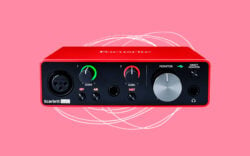Illustration: Daniel Zender
Impedance is a bit of physics that makes all the difference when hooking up speakers, headphones, and more.
The concept of impedance is vital to electrical engineering and can affect the sound coming out of our own audio devices. In this article, let’s explore what impedance is, and why it can be important for both making and listening to music.
What is impedance?
In simplest terms, you can think of impedance as resistance. In electrical engineering, it’s the opposing force presented by a circuit to the flow of alternating electrical current once a voltage is applied, measured in ohms (Ω). You can see the relationship between these three variables in Ohm’s Law, named after the German physicist Georg Simon Ohm:

Voltage (V) = electrical pressure, measured in volts
Resistance (R) = electrical resistance, measured in ohms
Current (I) = rate of electrical flow, measured in amperes
Impedance is resistance when talking about alternating currents (or AC), like in the case of audio signals. Increasing the resistance at a constant voltage will lower the current in a circuit, and increasing the voltage at a constant resistance will increase its current.
Why is it important?
So how does all of this apply to sound? Well, impedance and resistance can affect anything that electrical audio signals pass through—even the highly-conductive copper wire inside many audio cables has its own electrical resistance that can increase as it becomes thinner or travels further.
Impedance can be especially important when it comes to powering headphones or speakers, because you’ll get the most efficient (and safest) transfer of electrical power by matching your playback device to an amplifier that complements its impedance. Let’s run through two common examples:
1. Passive speakers
Most studio monitor speakers are classified as active, meaning they come with their own built-in power amplifier and you don’t really need to worry about impedance. However, many stereo speakers (like the ones that use thin copper speaker wire) are passive and need incoming audio signals to be amplified by something like a stereo receiver.
Impedance ratings for passive speakers are normally between 4 ohms and 16 ohms, while amplifiers or receivers are rated within a given range like 6 ohms – 12 ohms. Check the back of these devices or the manufacturer specifications for this info!
If the impedance of your speakers is higher than what the amplifier is rated for, that’s technically fine—the amp just won’t be able to provide its maximum power output. What you’ll want to avoid at all costs is hooking up speakers with a lower impedance than what the receiver or amplifier is rated for. If the resistance goes down, Ohm’s Law tells us that either the current or voltage must increase, which will draw more power than what a connected amp is capable of delivering. This can cause the audio to distort and even lead to serious damage of your amplifier over time.
2. High-impedance headphones
Most consumer-grade headphones have generally low impedance ratings, often between 8 and 32 ohms. This means that the device they are being plugged into (like a laptop or phone) doesn’t need to work very hard to “drive” the headphones, or push enough voltage into the circuit’s current to effectively amplify incoming audio signals for our ears.
However, some higher-grade headphones meant for monitoring or mixing might come with impedance ratings like 250 ohms or higher. These cans often need way more amplification power than what your laptop or phone can provide on their own in order to play audio at reasonable volumes. This power can be supplied by hooking them up to an audio interface or a dedicated headphone amplifier.
Because high-impedance headphones can contain more delicate circuitry, they technically operate more efficiently and with less distortion, which can result in better overall sound output. That said, this doesn’t mean that low-impedance headphones can’t sound good too!
Did we miss anything about impedance? What topics in audio technology would you like to see us explore next? Start a conversation with us and other audio engineers via the Splice Discord.
Explore more key topics in audio technology:
January 21, 2022

.svg)
.svg)




